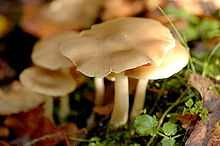Entoloma rhodopolium
| Entoloma rhodopolium | |
|---|---|
 | |
| Scientific classification | |
| Kingdom: | Fungi |
| Division: | Basidiomycota |
| Class: | Agaricomycetes |
| Subclass: | Hymenomycetes |
| Order: | Agaricales |
| Family: | Entolomataceae |
| Genus: | Entoloma |
| Species: | E. rhodopolium |
| Binomial name | |
| Entoloma rhodopolium (Fr.) P. Kumm. | |
| Entoloma rhodopolium | |
|---|---|
|
| |
| gills on hymenium | |
| cap is convex | |
| hymenium is adnate | |
| stipe is bare | |
| spore print is pink | |
| ecology is mycorrhizal | |
| edibility: poisonous | |
Entoloma rhodopolium, commonly known as the wood pinkgill, is a poisonous mushroom found in Europe and Asia. In fact, it is one of the three most commonly implicated fungi in cases of mushroom poisoning in Japan (Other two are Omphalotus guepiniformis and Tricholoma ustale). E. rhodopolium is often mistaken for edible mushroom, E. sarcopum. Symptoms are predominantly gastrointestinal in nature, though muscarine and choline have been isolated as toxic agents.
The taxonomy of this species is currently unclear, with several different forms identified in North America, and questions over whether the European and North American fungi are even the same species.
Entoloma is a genus of pink spored fungi. An alternate scientific name seen is Rhodophyllus rhodopolius, from Quelet's broader genus containing a larger subsection of pink-spored fungi.
Entoloma nidorosum, previously considered a separate species, is now classified as a variety of this fungus.
